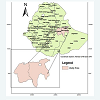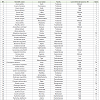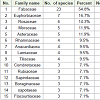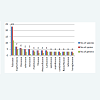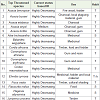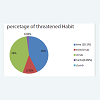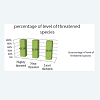Research article
Participatory Assessment of Threatened Forest Species in Hararge Area, Eastern Ethiopia: Community Based Participatory
Tahir Abdala*, Girma Eshetu and Abebe Worku
Ethiopian Biodiversity Institute, Harar Biodiversity Center P.O. Box: 1121, Harar, Ethiopia
Corresponding author: Tahir Abdala, Ethiopian Biodiversity Institute, Harar Biodiversity Center P.O. Box:1121, Harar, Ethiopia, E-mail:tahirabdala34@gmail.com
Citation: Abdala T, EshetuG, Worku A. Participatory Assessment of Threatened Forest Species in Hararge Area, Eastern Ethiopia: Community Based Participatory. J Plant Sci Res. 2017;4(1): 166.
Copyright © Abdala T, et al. 2017. This is an open access article distributed under the Creative Commons Attribution License, which permits unrestricted use, distribution, and reproduction in any medium, provided the original work is properly cited.
Journal of Plant Science & Research | ISSN: 2349-2805 | Volume: 4, Issue: 1
Submission: 20/04/2017; Accepted: 26/04/2017; Published: 04/05/2017
Abstract
Ethiopia was endowed with abundant and diversified flora and fauna. Spatially, forest ecosystem is one the more diversity and provide as home of ariety of life. Thus, wood vegetation that covered almost of the area is reduced since on miss management, limited awareness of forest value and high population pressure. Particularly, Harari region and eastern and west Hararge zone the forest resource dramatically degraded due to limited agricultural land,over grazing, limited awareness of forest value, due to high population pressure to extending agricultural land, mismanagement and recurrent drought these natural resource have dwindled dramatically. The study was conducted in eastern part of Ethiopia both Hararge zone. The aim of the study was to collect and document threatened Forest Biodiversity species found in Hararge, eastern Ethiopia; to identify threatened species for priority conservation. Data were collected community based participatory using single visit transect walk, informal interviews of elder community and review other literature. The collected data was summarized by table, percent and figure. A total of 116 forest species were recorded. Out of them 43.1% plant species were highly threatened, 23.3% species near threatened, 33.3% plant species are least. So that, 43.1% and 23.3% plant species were highly threatened, and near threatened respectively. Hence, the following recommendations were suggested for urgently conservation: Carry out further study on the population and population distribution of the priority species selected for genetic conservation in the area; Raise public awareness on the value of forest genetic resources and the problems related to loss of genetic information and devise a mechanism by which human impacts can be minimized through discussion and consultation with the local people; Establish legal basis for the in situ and ex situ conservation sites for the conservation of the priority species.
Keywords: Ethiopia; Forest resource; Hararge; Rare; Threatened
Introduction
Ethiopia’s status on International and National legal frame works regarding Biological resources
Ethiopia is one of the top 25 biodiversity-rich countries in the world [1], and hosts two of the world’s 34 biodiversity hotspots, namely the Eastern Afromontane and the Horn of Africa hotspots. It is also among the countries in the Horn of Africa regarded as major centre of diversity and endemism for several plant species. The Ethiopian flora is estimated to about 6000 species of higher plants of which 10% are considered to be endemic [2]. Woody plants constitute about 1000 species out of which 300 are trees.
Forests form the major constituents of vegetation resources and thus conservation of Forest Genetic Resources (FGRs) is among the priority areas of biodiversity conservation in Ethiopia. Efforts have een made to conserve and sustainably utilize FGRs in the country. Notable examples of such efforts are floristic, structure and socioeconomic studies of woody plant species in Afromontane forests of the country; FGR conservation strategies and establishment of in situ and ex situ conservation sites.
Studies have shown that tropical forests are being destroyed at an alarming rate [3-6]. Deforestation has been contributing to a decline in forest cover, loss of biodiversity both at global and national levels [7,8]. Poverty and lack of alternative livelihoods have been driving forces of forest destruction. The forest genetic resources conservation stratagem of Ethiopia (2002) and proclamation on forest development, conservation and utilization (2007) had identified deforestation as major threat to Ethiopians forest biodiversity [9,10]. Deforestation of agricultural land as a result of over-increasing population growth, increase demand for fuel wood and construction material, illegal settlements within forests, logging, and the expansion of illegal trade were considered major contributing factors to the loss of forest resources. The reduction in forest cover and loss of forest genetic resources pose serious threat to conservation of biodiversity.
The annual rate of deforestation in Ethiopia was found to beextremely high [11,12]. The major causes of deforestation were reported elsewhere [15-17]. This unprecedented deforestation rate is considered a major threat to the Ethiopian biodiversity [15,16,18-21] and the habitats of the 120 threatened endemic plant species of Ethiopia [22].
A century ago Ethiopia was endowed with abundant and diversified flora and fauna. Spatially, forest ecosystem is one the more diversity and provide as home of variety of life. It also an integral part of natural resource base of the country that have been devastated. Thus, wood vegetation that covered almost of the area is reduced since on miss management, limited awareness of forest value and high population pressure. This reduce of natural resource has lead negative impact on socio-economy of the country and diminish genetic resource of indigenous plant.
Particularly, Harari region, eastern and west Hararge zone the forest resource dramatically degraded due to limited agricultural land, over grazing, limited awareness of forest value, due to high population pressure to extending agricultural land, mismanagement and recurrent drought these natural resource have dwindled dramatically. Moreover, unestablishment forest protected area and law are the main cause in region. As well as, limited floristic document on forest diversity and conservation status are tackle for future conservation and research. These situations are urgently called for forest data collection and writing forest biodiversity resource document in this region. Therefore, the objectives of this study was to collect and document tree and shrub species found in Harari, eastern and west Hararge; to identify threatened species for priority conservation; to provide data for forest conservation and research.
Methodology
Description of the study area
The study was conducted in the eastern part of Ethiopia. Both zones of Hararge, West and East, located in Oromyia Region and Harari. It is situated approximately 200 km from the capital, Addis Ababa .it is bordered by east Showa zone in the west, Arsi zone is in south west, Bale zone in the south, Somali National Regional State in the east and south-east, and Dire Dawa Administrative Council in the north. Harari Regional State is encircled by the East Haraghe zone (Figure 1). The study area has 541 kebeles from east Hararge, 449 from west Hararge and 36 from Harari which have totally 1026 kebele. The study area has the total area of 2,262,266 km2 from east Hararge and 1,723,000 km2 from west Hararge .The physiographic condition of the Hararge zone is characterized by plateaus, rugged dissected mountains, deep valleys, gorges and plains. There are various prominent mountains and peaks in the zone and Kundudo and Gara Mullata mountain chain are the major ones.
Methods of data collection
The data were collected from both primary and secondary datacollection.
Primary data collection: The primary data were collected through community based participatory approach us Ing reconnaissance survey of single field visit, transect walk and informal interviewing with farmers and elder of local community who know perfectly the past endangered tree species and confidentially who know perfect local name. As well as, during field observation we have been collected data with picture of tree and shrub. Scope of our observation Harari region, Babile, Jarso, Gara Mullata, Meta, Qarsa & Fadis and Kurfa Chaleworedas in East Haragehe zone of Oromia regional state. And Also Habro, Hirna, Malka Ballo Woreda and Ades Forest Protected Area From West Hararge. During informal interview respondent was requested to categorize level threatened forest species into three categories: High, Medium and low. Where ‘High’ represent highly threatened plant species. When the population of the plant is rare and low distributed in the study area (first priority). Where’ medium ‘represent near threatened plant species (second priority). When the population of plant species some was present but, not much abundant generation. Where ‘low’ represent least threatened plant species. When the population of plant species was good regeneration. To identify three criteria through, asking the distribution of plant species: Asking trends of plant species; Endemic/indigenous of species: Asking the origin of plant species; How much importance of species: Asking importance of individual species.
Secondary data collection: Secondary data were collected widely data from referring many documents from Azenabekele. Use full tree and shrubs of Ethiopia, referring the published Hedberg I, Friis I and Person E. General Part and Index to Volume 1-7. Flora of Ethiopia and Eritrea Volume 8: The National Herbarium, Addis Ababa, Ethiopia and Uppsala, Sweden for species identification and provided further guidance, as did the authors’ experience.
Species identification
Species identification of most plant species were identified in the field and most taxonomically known. The species were also identified in the field with the help of district experts, individual informants and with the help of literatures following similar method, as well as using guide books such as ‘Useful trees and shrubs of Ethiopia’ by Azene et al. and referring the published Hedberg I, Friis I and Person E. General Part and Index to Volume 1-7. Flora of Ethiopia and Eritrea Volume 8: The National Herbarium, Addis Ababa, Ethiopia and Uppsala, Sweden.
Data analysis
The collected data were mostly analyzed and summarized by Table 1. The data on level of plant threat, local name, family and scientific name was analyzed by descriptive statics such as, Table, graph and percentage by using Excel Microsoft.
Result and Discussion
Forest composition of study area
The study of the vegetation data revealed that a total of 119 plant species were registered from study area. This all were belong to 42 families and 86 genera. Of these, Fabaceae is most dominant family comprises species 23(54.8%). This is in harmony with the findings of Mohammed Omer (2011) who find a total family of Fabaceae 22. Euphorbiaceae is the second dominant family comprised 7(16.7%) species each. Rosaceae and are the third family holds 6(14.3%) species. Moraceae and Asteraceae are the fourth family compromise 5(11.9%) species. Rhamnaceae, Tiliaceae, Lamiaceae, and Ancardiaeae) are the fifth family holds 4(9.5%) species each. Sapindaceae, Boraginaceae, Combretaceae, Sapotaeae, Flacourtiaceae, and Rubiaceae are sixth family comprise 3(7.1%) species. Simaroubaceae, Burseraceae, Apocyno, Myrtaece, Oleaceae, Acanthaceae and Capparidaceae are the seventh family holds 2(4.8%) species. 22 families were represented by more than one species while 20 families were represented by a single (2.4%) species each. The genus Acacia was represented by 10 species, Ficus by 5 species, Grewia, vernonia, rhusand Euphorbia were represented by 3 species each, Cordia, Combretum, Grewia, Prunus, Ziziphus, Kirkia, Ocimum, Indigofera, Cordia, Comiphora, and Albizia by 2 species each and the rest contained a single species each (Table 2 and Figure 2). On the other hand, the remaining family of the survey area comprises one species each (i.e. 0.86 % of total number of species).
Table 2: The top twelve dominant families with holds>3 the highest number of species in the study area .
As above table show total of 116 forests plant species were dentified. According to this all identified plant species level of threatened plant species were determined by knowledge of local community. Among all determined plant species 53(45.7%) species were categorized under highly threatened, 26(22.4%) species were categorized under medium threatened and 37(31.9%) species were categorized under low/least threatened. According to this finding the 18(15.5%) recorded woody plant species were already nationally red listed (following the IUCN threat categories) as being threatened species. These include Acacia negrii, Acanthus sennii, Cadaba divaricata, Erythrina brucei, Euphorbia burger, Euphorbia dalettiensis, Hillebrandia sandwicensis, Indigofera rothii, Kirkia burgeri, Kotschyana curvifolia, Millettia ferruginea, Rhus glutinosa, Rhynchosia erlangeri, Senecio lyriocephalus, Sparmannia macrocarpa, Syzygium guineense, Vernonia phillipsiae and Vernonia rueppellii. According IUCN red data from the total of 17 endemic plant species in study area, six plant species or 35.3% are categorized under VL (vulnerable), 4/23.5% plant species are categorized under EN (Endangered), 3/17.6% plant species are categorized under LC (least concern) and 2/11.8% plant species are categorized under NT (near threatened) see (Appendix 1). And also, 10(8.6%) plant species of this finding are similar with (List of trees and other woody forest species considered to be threatened in Ethiopia [21,22]. This includes Cordia africana, Hagenia abyssinica, Juniperus procera, Prunus africana, Gardenia ternifolia, Ficus vasta and Podocarpus. Out of total recorded 22(19.6%) of shrub and tree plant species categorized under highly threatened by community and 23(17.0%) of forest species are endemic and already listed under red data. Therefore, there are need urgent and priority conservation.
Indigenous knowledge on threatened forest plant resourcein study area
The majority of the respondents and Expert in study area had good knowledge about the use and regeneration status of species in their vicinity (Table 3). They were able to identify the species and type of Plant species they produce. Moreover, most of the respondents, mainly the elders have good knowledge on the different uses of the study species (Table 3). Regarding the current status of the study species, respondents recognized the declining state of the natural regeneration of some of the useful study species in the area. Nearly 100% of the respondents pointed out that recurrent drought, increased human population and expansion of agricultural land, over use species for medicinal, charcoal, timber, improper use of gum and resin and over domination of few species as a result of prohibition of human induced bush fire are the main factors affecting the natural regeneration of these useful species. About 51% of the respondents indicated that overgrazing impacted natural regeneration in two ways in the form of trampling and browsing of seedlings. During the field survey, local people were invited to identify the status of forest species in the area, whether they are increasing or decreasing. They identified about 50 forest tree and shrub species are under highly threatened. Among them, 27 of them are most important and top threatened in study area. Tree, 8 of them is shrub, 3 are shrub/tree and except 1 species is Herbs (Table 3).
Threatened habit types
As the (Figure 3) show that 50 plant species are identified from study are tree, 44 species are shrub, 16 species are tree/shrub and clumber and herbs holds 3 species each. From the total of 50 recoded tree plant species in study area 21(18.1%) species are under highly threatened, 12(10.34) species under medium threatened and from the total of 44 shrub plant species 21(18.1%) species are under highly threatened and 9(7.7%) shrub species are under medium threatened. 16(13.8%) plant species tree or shrub habit in study area. From the total of 16 tree/shrub species 6(5.2%) species under highly and medium threatened respectively. According to this data tree plant species are the most dominant and followed by shrub. However, both are equal high threatened in the study are that means represented by 21 (18.1%) plant species are highly threatened for both tree and shrub. Where clumber and herbs are held 3(2.6%) species each from total of 116 and 1(0.86%) plant species from herbs habit is under highly threatened. As this data described shrub and tree are more used and degraded by local community than herbs (Figure 2 and Table 3).
According to above (Figure 4) indicated that a total of 116 plant species were identified. Of these, 50(43.0%) categorized under highly threatened (priority conservation) based, 27(23.3%) near threatened second conservation), 39(33.6%) under least threatened. So, a plant species recorded under Highly threatened are Rare and few individual distribution in study area it need priority conservation and when plant under near threatened were need second conservation.
Conclusion and Recommendation
The objective of this community based participatory survey wasto identify the threatened forest genetic resource in eastern Ethiopia for recommending appropriate genetic conservation approaches in the area. The 116 forest species were collected from Harari region, eastern and west Hararge based on community participatory. From total of this 50(43.1%) highly threatened plant species, 27(23.3%) near threatened plant species, 39(33.6%) least threatened plant species. From the total species recorded, 17 species are already listed in the IUCN red data and recommended as high threatened by community knowledge. This includes Acacia negrii, Millettia ferruginea, Cadaba divaricata, Erythrina burana, Hagenia abyssinica, Juniperus procera, Prunus africana and Podocarpus [22]. The record of population structure shows that 50(43.1.0%) plant species identified by local community as highly threatened and from 50 plant species 6 species are vulnerable and four are endangered as listed in IUCN red data. Therefore, all 50 plant species identified by community knowledge from study area have abnormal population structures with no or few individual’s distribution in study area. These species need urgent conservation measures that will facilitate healthy regeneration and guarantee sustainable use of these species. Hence, the following recommendations were suggested:
• Carry out further study on the population and population distribution of the priority species selected for genetic conservation in the area.
• Raise public awareness on the value of forest genetic resources and the problems related to loss of genetic information and devise a mechanism by which human impacts can be minimized through discussion and consultation with the local people.
• Carry out further studies on the patterns of ecosystem functioning, biology and ecology of the key stone species to be able to restore the composition and structure of the forest.
• Establish legal basis for the in situ and ex situ conservation sites for the conservation of the priority species.
• Conduct research on storage behavior (seed physiology) and reproduction biology of woody species that focus on threatened and economically important species.
• Increase traditional forest management like, home garden and on-farm conservation.
References
- Groombridge B (1994) Biodiversity data source book. World Conservation Monitoring Centre (WCMC), World Conservation Press, Cambridge, UK.
- Hedberg I, Friis I, Person E (2009) Flora of Ethiopia and Eritrea, Vol. 1. National Herbarium, Addis Abeba, university.
- Hartshorn GS (1989) Application of gap theory to tropical forest management: Natural regeneration on strip clear-cuts in the Peruvian Amazon. Ecology 70: 567-576.
- Sabogal C (1992) Regeneration of tropical dry forest in Central America, with examples from Nicaragua. J Veg Sci 3: 407-416.
- Legesse N (1995) Indigenous trees of Ethiopia: Biology, uses and propagation techniques. Addis Ababa University Press.
- Teketay D (1996) Seed ecology and regeneration in dry Afromontane forest of Ethiopia. University of Agriculture Sciences. The woodland.
- Skole D, Tucker C (1993) Tropical deforestation and habitat fragmentation in the Amazon: Satellite data from 1978 to 1988. Science 260: 1905-1910.
- Environmental protection Authority (EPA) (2015) The federal democratic republic of Ethiopia. Addis Ababa, Ethiopia.
- German Development Cooperation (GIZ), Institute of Biodiversity Conservation and Research (IBCR) (2002) Forest genetics resources conservation strategy of Ethiopia. Addis Ababa.
- (2007) A proclamation to provide for the development conservation and utilization of forests. Proclamation no.542/2007, Addis Ababa, Ethiopia.
- Reusing M (2000) Change detection of natural high forests in Ethiopia using Remote Sensing and GIS techniques. Int Arch Photogramm Remote Sensing 33: 1253-1258.
- Tedla S (1995) Protected areas management crisis in Ethiopia. Walia 16: 17 - 30.
- Tewold Berhan GE (1990) The importance of Ethiopia forests in the conservation Arabic coffee gene-pools. Commun Inst Gen Bot Hamburg 25: 65-72.
- Hamito D (2001) Research methods in forestry: Principle and practices with particular reference to Ethiopia. FAO.
- Woldemariam T, Teketay D (2001) Imperative problems associated with forestry in Ethiopia: Proceeding Workshop organized by Biological Society of Ethiopia. Addis Ababa University, pp. 154.
- Engels JM, Rao VR, Brown AH, Jackson MT (2002) Managing plant genetic diversity. IPGRI, CABI Publishing, CAB International, UK, pp. 2-481.
- Government of the federal democratic republic of Ethiopia (2015) Ethiopia's National biodiversity strategy and action plan 2015-2020. Ethiop Biodivers Inst, Addis Ababa, Ethiopia.
- Teketay D (1992) Human impact on a natural montane forest in southeastern Ethiopia. Mount Res Dev 12: 393-400.
- Gole TW (2003) Vegetation of the yayu forest in southwest Ethiopia: Impacts of human use and implications for in situ conservation of wild Coffea arabica L. populations. Ecol Dev Series.
- Senbeta F, Denich M (2006) Effects of wild coffee management on species diversity in the Afromontane rainforests of Ethiopia. For Ecol Manag 232: 68-74.
- (2012) The state of forest genetic resources of Ethiopia. Country report submitted to FAO. Addis Ababa, Ethiopia, IBC, pp. 2-58.
- Vivero JL, Kelbessa E, Demissew S (2005) The red list of endemic trees and shrubs of Ethiopia and Eritrea. Cambridge, GB: Fauna and Flora International, pp. 23.

